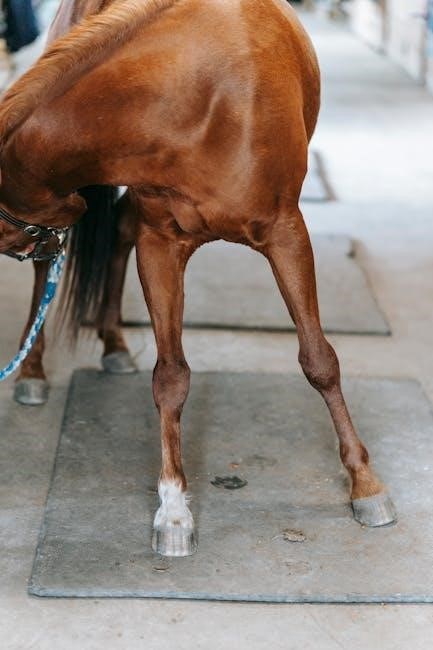Equine joint injections are a common treatment for managing pain and inflammation in horses, aiming to improve mobility and overall joint health. They play a crucial role in veterinary care.
1.1 What Are Equine Joint Injections?
Equine joint injections involve administering therapeutic substances directly into a horse’s joints to address pain, inflammation, and degeneration. Commonly used medications include corticosteroids, hyaluronic acid, and polysulfated glycosaminoglycans. These injections are typically performed by veterinarians to target specific joint tissues, aiming to reduce swelling, improve lubrication, and restore joint function. They are often used in horses with osteoarthritis or other degenerative conditions to enhance comfort and maintain mobility, making them a critical tool in equine healthcare.
1.2 Importance of Joint Health in Horses
Joint health is critical for a horse’s overall well-being and performance. Healthy joints enable proper movement, support the horse’s weight, and absorb shock during activity. Degenerative joint conditions can lead to pain, lameness, and reduced mobility, significantly impacting the horse’s quality of life and athletic ability. Maintaining joint health through proper care, nutrition, and veterinary interventions is essential for preventing long-term damage and ensuring horses remain active and comfortable throughout their lives.

Understanding the Anatomy of a Horse’s Joints
A horse’s joint is a complex structure designed for flexibility and strength. It consists of bones, cartilage, the joint capsule, and synovial fluid. Ligaments and tendons provide stability and facilitate movement. Understanding this anatomy is crucial for effective joint injections, ensuring medications target the correct areas to maximize therapeutic benefits. Proper anatomical knowledge helps in maintaining equine mobility, preventing injuries, and ensuring overall joint health and longevity.
2.1 The Structure of a Normal Joint
A normal horse joint consists of bones, cartilage, a joint capsule, and synovial fluid. The joint capsule encloses the space, while the synovial membrane produces fluid that lubricates the joint. Hyaline cartilage covers the ends of bones, allowing smooth movement. Ligaments and tendons provide stability and support. The joint’s structure enables flexibility, load-bearing, and movement. Understanding this anatomy is essential for diagnosing issues and administering effective treatments, ensuring optimal joint function and equine performance.
2.2 Common Joints Targeted for Injections
In horses, the most commonly injected joints include the knee, hock, fetlock, and coffin joints. These joints are prone to stress and inflammation due to their high-load-bearing roles. The knee and hock are frequently targeted for their susceptibility to osteoarthritis, while the fetlock and coffin joints are critical for lameness issues and navicular syndrome. Accurate identification of the joint and its condition ensures effective treatment, making these areas primary focuses for therapeutic interventions to maintain mobility and performance in equine athletes.

Why Are Joint Injections Used in Horses?
Joint injections are primarily used to reduce pain and inflammation, improve mobility, and maintain joint health in horses, thereby supporting their overall well-being and performance.
3.1 Treating Joint Inflammation and Pain
Joint injections are a highly effective method for addressing inflammation and pain in horses. By delivering anti-inflammatory medications, such as corticosteroids, directly into the joint, they target the source of discomfort, reducing swelling and alleviating pain. This approach is particularly beneficial for conditions like arthritis or synovitis, where inflammation leads to stiffness and impaired mobility. The localized administration ensures maximum efficacy with minimal systemic side effects, providing relief and supporting the horse’s recovery and comfort.
3.2 Enhancing Joint Lubrication and Mobility
Equine joint injections often include hyaluronic acid, which enhances joint lubrication by improving synovial fluid viscosity. This reduces friction between cartilage surfaces, promoting smoother movement and reducing wear. Improved lubrication not only supports joint mobility but also helps prevent further cartilage degeneration; Regular injections can maintain healthy joint function, particularly in performance horses, ensuring optimal athletic ability and reducing the risk of future joint-related issues. Enhanced lubrication and mobility are key to preserving the horse’s overall comfort and performance.

Diagnosing Joint Issues in Horses
Diagnosing joint issues in horses involves clinical exams, imaging techniques like X-rays, and joint fluid analysis to identify inflammation, degeneration, or injury.
4.1 Clinical Examination and Lameness Assessment
A thorough clinical exam involves observing the horse’s movement, palpating joints for pain or swelling, and performing flexion tests to assess stiffness. Lameness evaluation includes examining the horse at walk and trot, on straight lines and circles, and on different surfaces like inclines or hard ground. These assessments help identify affected joints and determine the severity of discomfort, guiding further diagnostic steps and treatment plans, including potential joint injections.
4.2 Diagnostic Imaging and JointFluid Analysis
4.2 Diagnostic Imaging and Joint Fluid Analysis
Diagnostic imaging, such as X-rays, MRIs, and ultrasonography, provides detailed insights into joint structures, identifying issues like fractures, cartilage damage, or soft tissue injuries. Joint fluid analysis, obtained through arthrocentesis, evaluates clarity, protein levels, and cell counts to detect inflammation or infection. These tools are essential for diagnosing joint conditions, guiding treatment decisions, and ensuring injections are administered effectively. Accurate diagnostics help veterinarians tailor therapies to address specific joint pathologies in horses.
Preparing for Joint Injections
Preparing for joint injections involves selecting appropriate medications, ensuring the horse’s readiness, and properly cleansing the injection site to minimize complications and ensure effectiveness.
5.1 Selecting the Right Medication
Selecting the right medication for joint injections is crucial for effectiveness and safety. Commonly used medications include corticosteroids and hyaluronic acid, each with specific benefits. Corticosteroids reduce inflammation, while hyaluronic acid improves joint lubrication. The choice depends on the severity of the condition, the horse’s health status, and potential allergies. Always consult a veterinarian to determine the most appropriate medication and dosage. Proper selection ensures optimal therapeutic results and minimizes risks of adverse reactions.
5.2 Preparing the Horse and the Injection Site
Proper preparation is essential for safe and effective joint injections. The horse should be clean, dry, and free from movement. The injection site must be disinfected using antiseptic solutions to minimize infection risks. The horse may be tranquilized to ensure stillness. The veterinarian will position the horse to access the joint easily. Hair around the site may be clipped for better visibility. Strict aseptic technique is maintained to prevent contamination. Proper preparation ensures the procedure is both safe and effective, reducing complications and promoting optimal outcomes for the horse.

Administering Joint Injections
Administering joint injections in horses involves carefully delivering medication into the joint space to relieve pain and improve mobility. Proper technique and sterile methods are crucial for success.
6.1 Intra-Articular Injection Techniques
Intra-articular injections involve delivering medication directly into the joint space. Proper sterile preparation and local anesthesia are essential to minimize discomfort and risk of infection. The needle is carefully inserted through the skin and joint capsule, guided by palpation or imaging to avoid tendons and ligaments. Once in place, the medication is slowly administered to ensure even distribution. This technique requires precision to target the synovial space effectively, ensuring optimal therapeutic results while preserving joint integrity and function.
6.2 Post-Injection Care and Monitoring
Post-injection care involves monitoring the horse for signs of lameness, swelling, or discomfort. Anti-inflammatory medications may be prescribed to reduce inflammation. The injection site should be kept clean to prevent infection. Monitoring for 24-48 hours is crucial to ensure no adverse reactions. Limiting high-impact activities for a few days allows the joint to heal. Regular follow-ups with the veterinarian are essential to assess the treatment’s effectiveness and adjust the care plan as needed. Proper aftercare helps maximize therapeutic benefits and prevents complications.

Potential Risks and Complications
Equine joint injections carry risks, including infection, septic arthritis, and adverse reactions to medications. While rare, these complications can lead to severe joint damage or systemic health issues.
7.1 Infection and Septic Arthritis
Infection is a serious risk with joint injections, potentially leading to septic arthritis. This occurs when bacteria enter the joint, causing severe inflammation, pain, and irreversible damage. Symptoms include swelling, heat, and lameness. Prompt veterinary intervention is critical to prevent long-term harm. Proper sterile technique during injections significantly reduces this risk. If untreated, septic arthritis can lead to permanent joint dysfunction, impacting the horse’s mobility and quality of life.
7.2 Adverse Reactions to Medications
Adverse reactions to joint injection medications can occur, ranging from mild to severe. Common reactions include allergic responses, such as hives or swelling at the injection site. Systemic effects, like gastrointestinal upset or diarrhea, may also happen, especially with certain medications. In rare cases, more severe reactions, such as anaphylaxis, can occur. Monitoring the horse closely after injection is essential to identify and address any adverse effects promptly. Always follow veterinary guidance to minimize risks and ensure safe administration.

Aftercare and Rehabilitation
Proper aftercare and rehabilitation are vital to ensure the horse’s recovery and joint health. This includes rest, monitoring, and a gradual return to normal activity under veterinary guidance.
8.1 Immediate Post-Injection Care
After joint injections, monitor the horse closely for signs of swelling, heat, or pain at the injection site. Provide a quiet, stress-free environment and avoid strenuous activity for 24-48 hours. Apply ice to reduce swelling if recommended by your veterinarian. Observe the horse’s behavior and gait for any adverse reactions. Ensure the horse remains comfortable and follows a controlled exercise plan to support the healing process and maximize the effectiveness of the treatment.
8.2 Long-Term Rehabilitation Strategies
Long-term rehabilitation involves a structured plan to restore joint health and mobility. Gradually introduce controlled exercise, such as walking and light trotting, to avoid overloading the joints. Incorporate strength and flexibility training through specific exercises or therapies like chiropractic care or acupuncture. Monitor the horse’s progress and adjust the rehabilitation program as needed. Maintain a balanced diet rich in joint-supporting nutrients. Regular veterinary check-ups are essential to ensure the horse’s recovery and prevent future issues. Consistency and patience are key to achieving long-term joint health.
Equine joint injections are a vital tool in managing joint health, offering relief from pain and inflammation while preserving mobility. Regular veterinary consultation ensures optimal outcomes for the horse.
9.1 Summary of Key Points
Equine joint injections are a critical treatment for managing pain and inflammation, enhancing mobility, and maintaining joint health in horses. Proper diagnosis, medication selection, and technique are essential for efficacy and safety. Regular veterinary consultation ensures tailored treatment plans, while post-injection care and rehabilitation support long-term well-being. Balancing immediate relief with preventive strategies is vital for optimizing outcomes and preserving the horse’s athletic and functional capabilities.
9.2 Importance of Regular Veterinary Consultation
Regular veterinary consultation is vital for ensuring the health and well-being of horses undergoing joint injections. A veterinarian can assess joint condition, adjust treatment plans, and monitor progress. They also help prevent complications and ensure the safety and efficacy of injections. Timely advice and interventions can address potential issues early, optimizing outcomes. Collaborating with a vet supports long-term joint health and maintains the horse’s athletic performance and quality of life. This partnership is essential for responsible and effective equine care.

